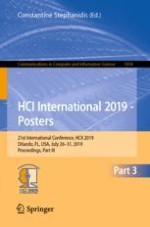2019 | OriginalPaper | Chapter
An Experiment of the Impacts of Workplace Configuration on Virtual Team Creativity
Authors : Xinlin Yao, Xixi Li, Cheng Zhang
Published in: HCI International 2019 - Posters
Publisher: Springer International Publishing
Activate our intelligent search to find suitable subject content or patents.
Select sections of text to find matching patents with Artificial Intelligence. powered by
Select sections of text to find additional relevant content using AI-assisted search. powered by
